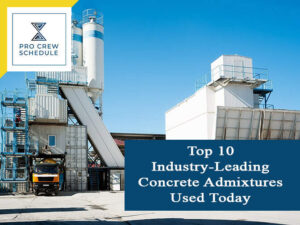As much as possible, concrete workability, strength, and water tightness must be achieved by choosing preferable aggregates, Portland cement, and better water-cement ratio maintenance. When this is not possible due to unusual situations such as hot temperatures, prolonged deicing salt exposure, increase wear or other chemicals, it is believed that admixtures are helpful. Ingredients added to the concrete other than aggregates, water, and Portland cement are commonly referred to as admixtures. While it is not usually required, there are several cases where admixtures are being used selectively in order to improve the concrete mix.
We will tackle concrete admixtures for today’s blog, its major purpose, including the top 10 leading concrete admixtures preferred to use today.
What are Admixtures and Why It is added to Concrete?
Admixtures are commonly used in concrete for altering their properties in many different ways. It improves a few concrete characteristics such as increasing or reducing cure time, enhancing workability and improving concrete durability. Admixtures are also used for aesthetic purposes, such as changing the cement colors.
Today, concrete mixes usually contain two or more concrete admixtures and it helps the pouring process. Driving down the costs is easier and productivity is improved when contractors will use a task scheduler software. The cost of the admixtures varies on the type and quantity of admixtures being used. All of these admixtures are added by meter cost/cubic yard of concrete. Furthermore, two common types of concrete admixtures today are – chemical admixtures and mineral admixtures.
· Chemical admixtures – are often used to enhance concrete quality, especially during placement, mixing, and transporting. It lessens construction costs and can alter any hardened concrete properties to ensure a better quality of concrete.
· Mineral Admixtures – it gradually affects the nature of the strengthened concrete through hydraulic activity. There are cementitious materials included in the process, such as silica fume and fly ash. Mineral admixtures can be used with blended cement other than the Portland cement.
Furthermore, admixtures are capable of providing the following results to concrete:
· To improve the rate of durability development during the early phase (calcium chloride is the widely used accelerator)
· To increase the concrete workability without having to change the water content
· To hinder the initial setting time while concrete is being pumped over long distances
· To increase the resistance of thawing and freezing
· To increase water tightness during mixing
· To reduce the evolution of heat
· Crack control (reduction of shrinkage)
· Finish enhancements
· Flow-ability and set retardation
· To minimize the capillary flow of the water
· To reduce the rate of segregation and bleeding
The 10 Most-Used Concrete Admixtures
Let’s go over with the top 10 most commonly used concrete admixtures today.
1. Air-Entrainment
In terms of increasing freeze-thaw durability, air-entrained concrete is preferred to use. This particular admixture typically produces a much more workable concrete compare to the concrete that is non-entrained. Using this admixture, the resistance of the concrete tends to improve, which is really necessary. Here are some benefits that this admixture provides:
· High-degree of workability
· High-degree of durability
· High-resistance to rounding cycles of drying and wetting
The entrained air bubbles tend to act as a physical buffer caused by the stresses due to the augmentation of water volume in freezing temperatures. Admixtures like this are compatible with almost every single admixture available for mixing. Furthermore, compressive strength will most likely minimize by about 5%, usually for every 1% of entrained air.
2. Set-Retarding Admixture
Concrete admixtures such as set retarding are utilized to delay the chemical reaction that is taking place during the start of the concrete setting process. This type of concrete admixture is used to lessen the effect of high temperatures that can produce a quicker initial concrete setting. Set-retarding mixtures are also being used in the concrete pavement construction for a few reasons:
· Reducing additional costs to put up new concrete batch plants onsite
· Allows more time to complete concrete pavements
· Helps in eliminating cold joints in concrete
Furthermore, retarders can be used as well in resisting cracking due to the deflection of concrete. Concrete contractors must take note that concrete deflection occurs when horizontal slabs are being placed in different sections. Most retarders function as water reducers and might entrain air in concrete. For contractors, using builder trends software can really make a huge difference when it comes to handling procedures like this.
3. Accelerating
This type of admixture is used to increase further the rate of strength development for concrete. It is also used to lessen concrete setting time. The most common accelerator component in this admixture is calcium chloride. However, the component itself can possibly promote corrosion activities of steel reinforcement. Additionally, concrete best practices like an adequate cover, proper consolidation and concrete mix design can prevent any corrosion issues. Thus, accelerating admixtures are particularly useful for altering the properties of concrete during cold weather.
One of the best practices that is implemented today is the use of a construction scheduling software. With this, building projects are easier and faster to manage as well as the involved crew.
4. Water-Reducing concrete admixtures
Water-reducing is a type of concrete admixture that is chemical products. When any of these chemical products are added to concrete, it can create a desirable slump despite the lower-cement ratio. These admixtures are also used to gain specific concrete strength with the use of much lower cement content. Low cement contents usually result in lower carbon dioxide emissions and energy usage for every concrete volume produced.
With this kind of admixture, all concrete properties are best-improved and can withstand under any difficult conditions. In bridge decks, patching concrete, and low-slump overlays, water reducers are also primarily used. Recent advancements in admixtures have led to the continuous progress of mid-range water reducers. In current software advancements, builder software leads to constant improvement in project management and crew supervision.
5. Superplasticizers Admixtures
To produce flowing concrete with a higher slump ranging from 7-9 inches is the major purpose of using superplasticizers. Flowing concrete is used in heavily reinforced structures and is considered as placements. This usually happens when enough consolidation from vibration cannot readily be accomplished.
And another significant application of superplasticizers is the production of high-strength concrete. It has been discovered that only superplasticizers can improve concrete workability among other cement types. However, one problem related to the utilization of high-range liquid reducer, especially for concrete is slump loss.
6. Shrinkage reducing
These admixtures are generally added to concrete during preliminary mixing. The admixture itself can be reduced by long-term and early drying shrinkage. That is why it is best used in circumstances wherein shrinkage cracking can lead to stability issues. There are also other situations where huge numbers of shrinkage joints are found disagreeable for technical and economic reasons. In some cases, shrinkage reducing type of admixtures lessens strength development both at late and early stages.
7. Corrosion-Inhibiting
These admixtures are used to slow down corrosion, particularly in reinforcing concrete steel. It also falls into the category of specialty admixture. Corrosion inhibitors can considerably lessen maintenance costs of strengthened concrete structures with a service life of 30-40 yrs. Furthermore, admixtures like this have only little effect on the actual strength but might accelerate early durability development.
Calcium nitrate does accelerate the setting times of concrete over various curing temperatures unless it will be formulated using a set retarder to balance the speed-up effects.
8. Silica Fume Admixtures
This concrete admixture is also referred to as micro silica. It is a powder that comes from an electronic semiconductor chip. It is proven to be many times finer compared to Portland cement and primarily consists of silicon dioxide. When this admixture is added to the concrete mix, it produces extremely high-strength concrete and has low permeability.
Concrete contractors often made choices like this, especially for regions with high water tables and high moisture areas. Being wise enough in investing software tools like construction management software is also one thing to expect from them.
9. Best Furnace Slag
The best furnace flag comes from the manufacturing of iron. Aggregates like this are used for further workability improvements and increase the durability of the concrete. Additional benefits include reducing the rising temperature during the curing process, minimizing permeability, and improved sulfate resistance.
In situations wherein concrete is having a troweled finish, the best furnace slag is considered important. Therefore, the use of this admixture is proven to be very beneficial.
10. Gas-Forming Agents
Admixtures like gas-forming agents are added to concrete for one major purpose. When gas-forming agents are added, it causes a slight expansion before it will finally harden. A generally used gas-forming admixture is known as aluminum powder.
It produces gas bubbles having small hydrogens and reacts to hydroxides. It will also help in eliminating any voids that are usually caused by the settlement of concrete.
Key Takeaways
New sorts of concrete admixtures have experimented continuously today. Some offer environmental benefits and can help in lessening pollution by the reduction of Portland cement production. There are other types of aggregates today that are experimented to allow concrete to absorb and self-heal naturally. As these aggregates start to gain more acknowledgment, it will most likely play a huge role in constructing roads, buildings, or any other types of concrete structures.








1 thought on “Top 10 Industry-Leading Concrete Admixtures Used Today”
IS code of superplastisizer and chemical composition